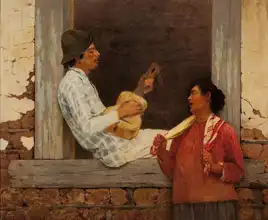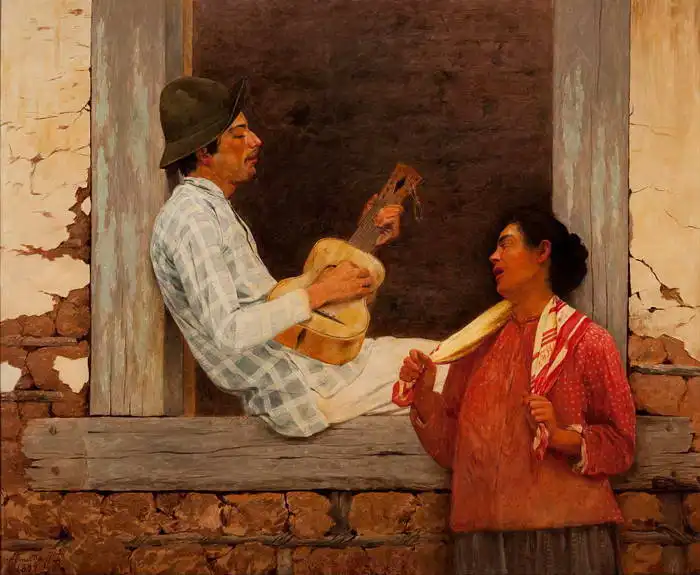About this finishing
Print. The image is printed on the top quality 10-ink HP Z9PS printer on HP matte 270 g / m2 paper. You can choose any size to an accuracy of 1 cm. A margin of 5 cm around the image is added to the size of the motif.


You can find a detailed description about our finishings
here.
Guitar player
The painting depicts a man and a woman in traditional dress at a music scene. The man sits on a wooden beam and plays a stringed instrument, probably a banjo or lute. He is wearing a blue and white striped shirt and a dark cap. A woman stands opposite the man, her mouth open as if singing or talking. She is wearing a red and pink top and a white and red striped scarf. The background is the dark wall of a house with peeling plaster.
This description was created by artificial intelligence, please be indulgent.
Prevailing color of this fine art print is vivid and its shape is landscape. This image is printed on demand - you can choose material, size and finishing.
Brazilian artist
José Ferraz de Almeida Júnior (1850-1899) started painting when he worked as a bell ringer at the church of Our Lady of Candelaria. In his free time, he painted several small paintings with religious themes. The chief priest was so impressed with his work that he organized a collection enabling Júnior to attend drawing lessons. In 1869, he studied at the Academia Imperial de Belas Artes. After graduation, he opened his own studio in order to earn a trip to Europe. In 1876, he exhibited in Sao Paulo, where he came to the attention of the Emperor Pedro II. He was so fascinated by his paintings, for example
Yearning and
Waterfalls, that he offered Júnior financial support. This fulfilled his dream to travel to Paris and study at the Beaux-Arts. After returning to Brazil in 1882, he gave lessons in his studio. He didn’t leave Sao Paulo even when he received an offer to become a professor of art history at the Academy. His life ended violently at the hands of his cousin, who stabbed him because of a long-standing affair with his wife. For his work from the Romantic period, Júnior was awarded the title of Knight of the Rose Order from the emperor.


